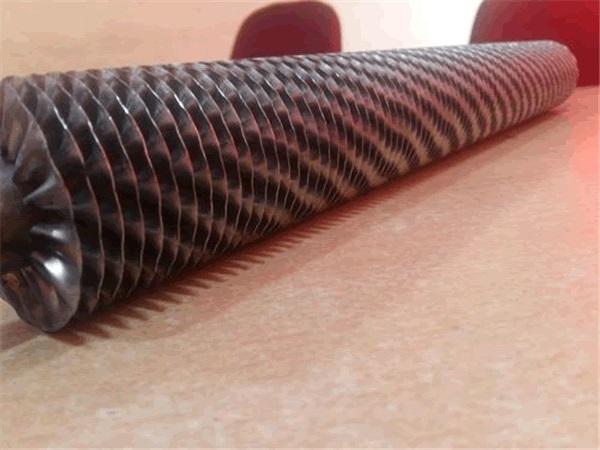Lord Fin Tube--Helically Wound Finned Tubes
What are helically wound finned tubes?
Helically wound finned tubes are heat transfer components used in various industrial applications, particularly in heat exchangers. These tubes consist of a core tube and a helically wound fin that is attached to the outer surface of the core tube. Helically wound finned tubes are an important component in a wide range of industrial applications, including chemical processing, power generation, and HVAC systems. These tubes are designed to increase the surface area of a heat exchanger, thereby improving its efficiency and performance.
At their core, helically wound finned tubes are simply tubes that have been wrapped with a continuous strip of metal. The strip is wound in a helical pattern around the tube, creating a series of fins that protrude from the surface. These fins serve to increase the surface area of the tube, allowing for greater heat transfer between the tube and its surroundings.
The specific design of helically wound finned tubes can vary depending on the application. For example, the fin height, fin thickness, and pitch (i.e. the distance between each fin) can all be adjusted to optimize performance. Additionally, different metals can be used for the fins themselves, depending on factors such as cost, corrosion resistance, and thermal conductivity.
Helically wound finned tubes benefits
1. One of the key benefits of helically wound finned tubes is their ability to improve heat transfer efficiency. By increasing the surface area of the tube, these fins allow for more heat to be transferred between the tube and its surroundings. This can result in significant energy savings, as less energy is required to achieve the desired level of heat transfer.
2. Another benefit of helically wound finned tubes is their ability to reduce the size and weight of heat exchangers. By increasing the efficiency of heat transfer, these tubes can allow for smaller and lighter heat exchangers to be used. This can be particularly important in applications where space and weight are at a premium, such as in aircraft or space-based systems.
Helically wound finned tubes material
The bare tubes can be any tube material, mainly carbon steel tube, alloy steel tube, stainless steel tube or copper alloy tubes.
The fins are typically made of aluminum, copper, or stainless steel and are tightly wound around the core tube to increase the surface area for heat transfer. The helical winding of the fins provides several benefits, such as increased heat transfer efficiency, improved tube rigidity, and reduced air-side pressure drop.
Helically wound finned tubes usages:
Helically wound finned tubes are commonly used in air-cooled heat exchangers, where they facilitate heat transfer from a hot fluid (usually a gas) to a cooler fluid (usually air) without the need for an intermediate heat transfer fluid. These tubes are also used in a variety of other industrial applications, including process heating and cooling, refrigeration, and power generation.
Helically wound finned tubes types:
G type fin tubes:
(Embedded Fin) The G fin strip is wound into a machined groove and securely locked into place by back filling with base tube material. This ensures that maximum heat transfer is maintained at high tube metal temperatures. Maximum operating temperature for this fin type is 450°C.
Fin material : Aluminium or copper
Tube materials : Carbon steel, Cr.-Mo. steel, stainless steel, copper, copper alloys, etc.
L type fin tubes:
L Fin strip material is subjected to controlled deformation under tension giving the optimum contact pressure of the foot of the fin onto the base tube thus maximizing the heat transfer properties. The foot of the fin considerably enhances the corrosion protection of the base tube. Maximum operating temperature for this fin type is 150°C.
Fin material : Aluminium or copper
Tube materials : Carbon steel, Cr.-Mo. steel, stainless steel, copper, copper alloys, etc.
Crimped type fin tubes:
This fin type (crimped fin) is a non taper fin wrapped under tension around the base tube. The finning process results in a crimp forming at the foot of the fin. Fin is then welded to the base tube at the strip ends. Maximum operating temperature for this fin type is 250°C.
Fin material: Carbon/stainless steel or copper.
Tube materials: Carbon/stainless steel.
KL type fin tubes:
Manufactured exactly as the L fin except that the base tube is knurled before application of the fin foot. After application the fin foot is knurled into the corresponding knurling on the base tube thereby enhancing the bond between the fin and tube resulting in improved heat transfer characteristics. Maximum operating temperature for this fin type is 260 °C.
Fin material : Aluminium or copper
Tube materials : No theoretical limits.Carbon steel, Cr.-Mo. steel, stainless steel, copper, copper alloys, etc.
I type fin tubes (semi crimped fin tube):
This fin type is a non taper fin wrapped under tension around the base tube. The finning process results in a crimp forming at the foot of the fin. Fin is then welded to the base tube at the strip ends. Maximum operating temperature for this fin type is 250 °C.
Fin material : Carbon/stainless steel or copper.
Tube materials : Carbon/stainless steel or copper and copper alloys.
In conclusion, helically wound finned tubes are an important component in many industrial applications. By increasing the surface area of a heat exchanger, these tubes can improve efficiency and reduce energy consumption. While they do have some limitations, their many benefits make them a valuable tool for engineers and designers looking to optimize the performance of their systems. Helically wound finned tubes are an efficient and reliable solution for heat transfer applications where high heat transfer rates and/or compact design are required.


